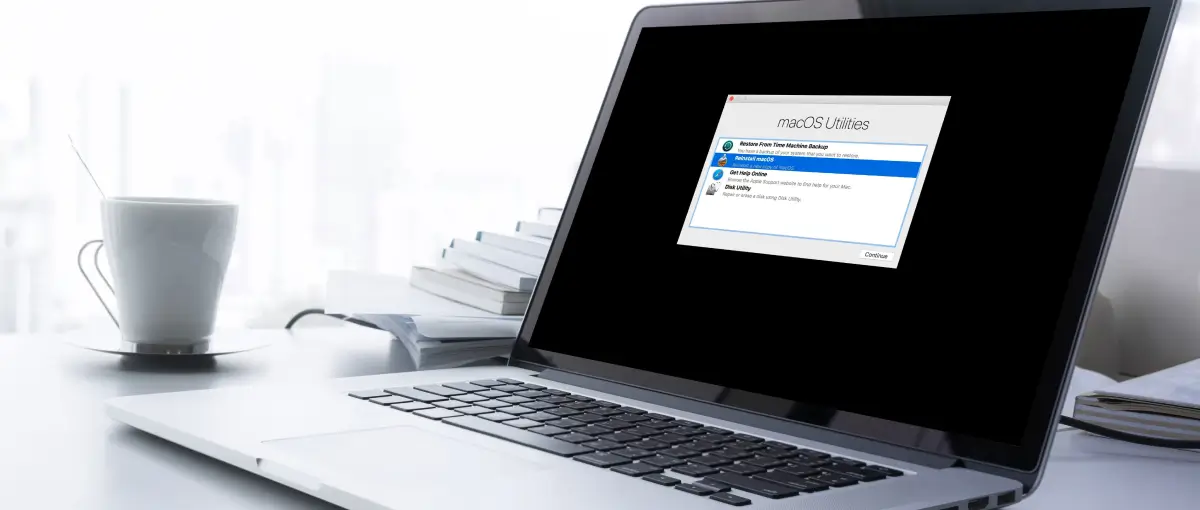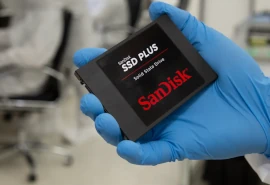Troubleshooting problems on a Mac or MacBook often involves using macOS Recovery.
macOS Recovery is a powerful, built-in tool to diagnose and resolve system issues on Macs. The standalone mode is designed to handle common issues, including logical errors, system restores, and clean installs of macOS.
This step-by-step guide explains how to use Mac recovery mode and outlines a simple approach for troubleshooting.
Key Takeaways:
- macOS Recovery is a self-contained environment with specialized tools to address common problems or scenarios.
- It runs a lightweight version of macOS to fix boot issues and file corruption or restore Macs to a previous point.
- Back up important data before using Mac recovery mode if possible.
- As an Apple Authorized Service Provider (AASP), we offer reliable Mac data recovery from Apple Certified Mac Technicians (ACMTs) if data loss persists.
When To Use Mac Recovery Mode

While macOS is a stable platform, some crashes and glitches are inevitable.
For that reason, Apple developed macOS Recovery, a built-in system for utilities that can diagnose, repair, and manage your Mac. The mode loads from a special partition on startup and provides access to useful tools without fully booting into macOS. The stripped-down version allows users to work through potential solutions when their Mac or MacBook encounters issues.
Here are some cases where macOS Recovery can help:
- Repair logical errors, such as file corruption, with the storage device
- Configure a volume or select a different boot drive
- Restore Mac to a prior point in time
- Migrate system to a new Mac
- Perform a clean install of macOS
- Wipe data from an old Mac before selling
- Use Terminal to isolate system-level issues
- Set or reset firmware passwords
These functions make macOS Recovery a versatile tool when troubleshooting problems.
How To Enter Mac Recovery Mode

There are two methods to enter macOS Recovery. In recent years, Apple transitioned from Intel processors to its own Apple silicon chipset. As a result, newer Macs have Apple’s M series processors.
Choose the boot option that aligns with the hardware of your Mac or MacBook.
To enter macOS Recovery on a model with an Apple silicon processor:
- Ensure the Mac is powered off. (Note: The screen is black and the Touch Bar and keyboard are not lit.)
- Press and hold the power button.
- Keep holding the power button as the Apple logo appears and the Mac loads startup options.
- Release the power button.
- Click the Options icon on the screen.
- Click Continue.
- Wait for the progress bar to fill.
- Select the admin account and click Next.
- Log in to the admin account and click Continue to access Mac recovery mode.
To enter macOS Recovery on a model with an Intel processor:
- Ensure the Mac is powered off. (Note: The screen is black and the Touch Bar and keyboard are not lit.)
- Press the power button.
- Press and hold the Command (⌘) and R keys simultaneously.
- Release the keys once the Apple logo or spinning globe appears.
- Wait for the progress bar to fill to access Mac recovery mode.
Consider these tips if you are having trouble entering macOS Recovery:
Timing of Keystroke: Ensure the Command (⌘) and R keys are pressed together after starting your Mac. If pressed too late, the computer will bypass Mac recovery mode and boot normally.
Faulty Keyboard: A failing keyboard may not register the strokes correctly. Try using an external keyboard if possible.
Damaged Partition: On rare occasions, the partition containing macOS Recovery might be corrupted. In such instances, use Internet Recovery by pressing Command (⌘), Option, and R at startup.
Software Conflicts:Sometimes, recent changes or updates can interfere with your Mac. Resetting NVRAM (non-volatile random-access memory) may resolve the conflict if you suspect this is the case. Restart the Mac or MacBook and press and hold Command (⌘), Option, P, and R for about 20 seconds.
Still cannot access Mac recovery mode? You can request help from an expert to learn about data recovery service options.
Key Features of Mac Recovery Mode
The following tools in macOS Recovery can resolve issues or improve the security and privacy of your Mac.
Run Disk Utility To Repair Internal Storage
Disk Utility is a tool that can sometimes diagnose and fix logical errors with the Mac’s system drive.
Using the First Aid tool in Disk Utility can lead to data loss in certain instances. If First Aid cannot repair corruption, it could delete metadata or remove files from blocks. These steps may lead to permanent data loss. If your system drive has physical damage, then running First Aid could worsen the problem. Back up before using Disk Utility if possible. If not, then assess the value of stored data before proceeding.
Here is how to use Disk Utility in macOS Recovery
- Select Disk Utility from the main menu.
- Click Continue.
- Choose the disk or volume you want to repair from the sidebar.
- Click the First Aid button at the top of the screen.
- Click Run.
- Click Done once the repair is complete and return to the macOS Recovery menu.
Note: Most Macs use Apple’s Security Integrity Protection (SIP) feature to prevent malware from editing macOS. First Aid cannot access the protected parts of the operating system. If that is where the issue resides, then you need specialized tools to gain low-level access.
Restore Time Machine Backup
You can restore a Time Machine backup in Mac recovery mode if you have already created one.
To restore a Time Machine backup in Recovery Mode:
- Select Restore From Time Machine Backup from the main menu.
- Click Continue.
- Connect the backup device and select it as the source.
- Choose the specific backup you want to restore.
- Confirm the destination disk. (Note: For most, it will be the Mac’s system drive.)
- Follow the on-screen prompts to restore the selected backup.
- Wait for the Mac to finish copying files and restart.
Restoring a snapshot can result in incremental data loss if users modified files or settings after the backup date.
macOS Recovery also provides access to Safari by selecting Get Help Online. This option launches a limited browser with disabled extensions and plug-ins. However, it allows users to access helpful websites, such as Apple Support. From there, users can navigate through frequently asked questions and relevant guides.
Reinstall macOS
Operating systems can become clunkier with use. There are various reasons macOS could become unresponsive, including software conflicts, app issues, and insufficient system resources.
Whatever the reason, reinstalling macOS could solve or rule out the problem. While reinstalling macOS does not mean it will delete stored data, you should still have a valid backup. If a corruption issue exists, your data could still be compromised, especially when using an encrypted file system.
To reinstall macOS in Mac recovery mode:
- Select Reinstall macOS from the main menu.
- Click Continue.
- Enter admin credentials if prompted.
- Choose Macintosh HD instead of Macintosh - Data. (Note: Macintosh HD is a read-only volume for system files. The other volume stores user data.)
- Wait for the clean installation of macOS to complete. (Note: Your Mac may restart several times.)
- Follow the on-screen instructions in the setup assistant once the installation finishes.
If the installer does not detect Macintosh HD, then your system drive could have severe file corruption. Our experts can often help in that event.
Access Terminal

Terminal is one of the most unforgiving macOS apps. It often demands a thorough understanding of commands. Beginners should be aware that incorrect syntax for a command can have adverse effects.
Here is how to access Terminal in macOS Recovery:
- Select Utilities from the main menu.
- Select Terminal.
- Enter the desired commands in the Terminal interface.
You should understand the function and potential consequences of each command before entering it. Improper usage could result in data loss and other major conflicts.
Set Firmware Password
A firmware password adds an extra layer of security to your MacBook. This password prevents unauthorized users from accessing macOS Recovery or other boot options in case of device loss or theft.
The following steps outline how to set a firmware password in Recovery Mode:
- Select Utilities from the main menu.
- Select Startup Security Utility or Firmware Password Utility.
- Click Turn On Firmware Password.
- Enter and verify your new password.
- Restart your computer.
The firmware password will now be required to boot the Mac.
If you forget this password, you will need to visit an Apple Store to reset it. That makes a firmware password a powerful security measure, but it can be inconvenient if forgotten.
How To Exit Mac Recovery Mode
Simply restarting your computer allows users to return to regular use.
To exit macOS Recovery:
- Click the Apple menu in the top-left corner of the screen.
- Click Restart.
Note: You can also choose a different startup disk from this menu.
Protect Your Data Before Using macOS Recovery
HHere are three smart steps to take before using Mac recovery mode to preserve critical data:
- Back up your data. Always back up your data before using Recovery Mode, especially if you plan to reinstall macOS or restore from a backup. This ensures that important data stays safe.
- Ensure you have a stable power source. Connect your MacBook to a power source to prevent it from shutting down mid-process, which could lead to further issues.
- Prepare the necessary information. Have your Apple ID, password, and Wi-Fi details available. You may need them during the process.
When To Seek Professional Help
macOS Recovery is a useful mode to troubleshoot common system issues. However, there are some data loss scenarios that these tools cannot address, such as hardware failure or complex file corruption. If that is the case, you will need a professional data recovery service to restore lost data.
The Apple data recovery experts at Secure Data Recovery have the expertise and experience to restore files from Mac and MacBook models of any generation. Our engineers have offered data recovery from hard drives and SSDs since 2007. Trust the service with Apple Certified Mac Technicians (ACMT), free quotes, and a No Data, No Recovery Fee guarantee. Our 96% success rate proves we know how to get the job done if all else fails.
Call 800-388-1266, request help, or find a location to speak with us and receive your free diagnostics and quote.









